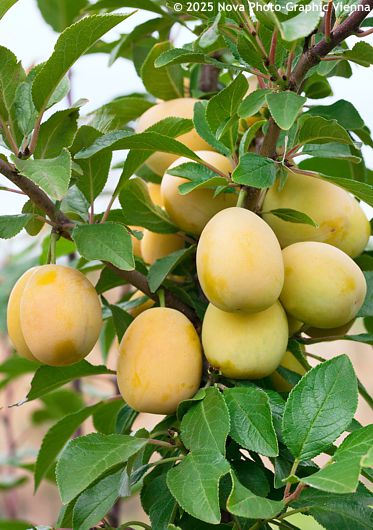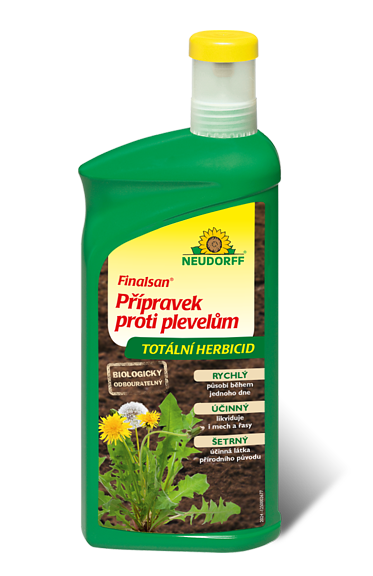
Prunus domestica 'Courod' GOLDUST® dwarf plum tree
Prunus
The genus Prunus, specifically the group of plums (Prunus domestica), includes a wide range of cultivated types that vary in fruit appearance, flavour and origin. In Europe, plums have been grown since at least Roman times, with the earliest records of domestication coming from Mesopotamia and the Caucasus. Over time, a colourful array of varieties has evolved from wild forms – from small, tart fruits to sweet, buttery globes. Thanks to this diversity, plums have become a favourite among breeders, who have developed trees suited to both large orchards and small balconies. Alongside cultivated types, wild species such as blackthorn (Prunus spinosa) and cherry plum (Prunus cerasifera) still grow in hedgerows and woodland edges across Europe, serving as valuable genetic resources for further development.
Dividing plums into types and names can be a bit of a maze, so let’s shine a light on them. True plums are elongated, dark blue to purple, with firm and richly flavoured flesh – ideal for drying, baking and distilling, and typically ripen late. Much earlier are large plums, still oval in shape but with softer, juicier flesh and a sweeter taste, often eaten right off the tree. Greengages, mostly Prunus domestica subsp. italica, are round, usually green or yellow, but also blue or red, with a buttery texture and high sugar content. Their variety names honour the French Reine Claude, named after Queen Claude of Valois, wife of Francis I. Mirabelles, small and golden, originate from Lorraine (France) and are prized for their fragrance and excellent preserving qualities. Bullaces, often confused with mirabelles, have firmer flesh, pronounced sweetness and are typically yellow to orange. They are commonly found in southern Czechia. Each group has its own distinct traits and uses, reflected in regional preferences and traditional recipes.
The dwarf plum GOLDUST® looks like something out of a fairytale – compact, with a small crown and delicate foliage, perfectly suited to balconies or terraces. It grows to just 1.5 to 2 metres tall yet bears fruit that could rival full-sized trees. The fruits are round to slightly oval, strikingly golden-yellow, and sometimes develop a gentle red blush on the sunny side when fully ripe. The skin is thin, the flesh juicy, sweet and aromatic, with a pleasant texture reminiscent of buttery greengages. The stone separates easily, which is a welcome trait for anyone who enjoys processing fruit without fuss. In terms of flavour, it ranks among the finest dwarf plums, with a balanced ratio of sugars and acids, suitable for fresh eating or light preserving. The variety was selected by Gilbert Cours-Darne (1909–2001) in the French town of La Romieu and introduced to the market after 2000 by the nursery Pépinières Darnaud under the trade name GOLDUST®, with the actual selection name being Courod.
This variety has a naturally compact growth habit, making it ideal for container growing, terraces, balconies or small gardens. It is mostly grafted onto St. Julien or VVA-1 rootstocks, which support compact growth, good hardiness and high productivity even in limited space. The tree forms a small, regular crown that requires minimal shaping – just a light trim after harvest. GOLDUST® is self-fertile, so it does not require a pollinator, though yields may improve in the presence of other plum varieties. It flowers mid-season, ensuring good compatibility with most grown cultivars.
Dwarf plums prefer full sun but will tolerate partial shade. The soil should be well-drained, ideally calcareous or neutral, with a pH around 6.5. Watering should be regular but careful – especially in containers, where moisture evaporates quickly. In containers, it is best to protect the tree in winter with hessian or move it to a sheltered spot, and water it once a month to prevent complete drying out. Do not consume the seeds inside the stones of stone fruits (except almonds), as they contain amygdalin, which can convert into hydrogen cyanide in the body and may be dangerous in larger quantities. Hardiness is great – down to at least –27 °C, making it suitable for most temperate regions.
Last update 19-10-2025

1 691,5 Kč

1 691,5 Kč
Goods are shipped all over Europe. For Russia and U.K. and for further details please read about SHIPPING OPTIONS HERE.
Are you interested in a serious discount for orders NOV-FEB? Check your options here.
THE PRICES INCLUDE VAT of 15%. For quick conversion you can use 1 CZK = approx. 0.04 EUR
- STANDARD QUALITY - Plants of this group are 1st class quality with number of branches and overall density adequate to their size and age, considering they were container grown.
- DE LUXE QUALITY - This label guarantees a luxurious quality of manually selected plants that, compared to their height and age, are exceptionally dense and beautiful.
- EXTRA - These plants are usually mature and bigger specimens with exceptional overall appearance.
- STANDARD (as described in the plant form) means a tree with a trunk of 190-210 cm and a crown at the top, unless specified differently. The commercial size for trees is their girth measured in the height of 1m from ground.
- HOBBY - These plants are of the same quality as our standard-quality plants but younger and therefore cheaper.
- SHRUB - a woody plant with branches growing bushy from the ground level.
- HALF-STANDARD or MINI-STANDARD - a small tree with shorter trunk, its size is usually specified.
- FEATHERED - These are trees with branches growing already from the base of the trunk and up along the stem.
- GRASSES and PERENNIALS - Sizes given usually read the diameter of the pot or the clump, as specified.


































